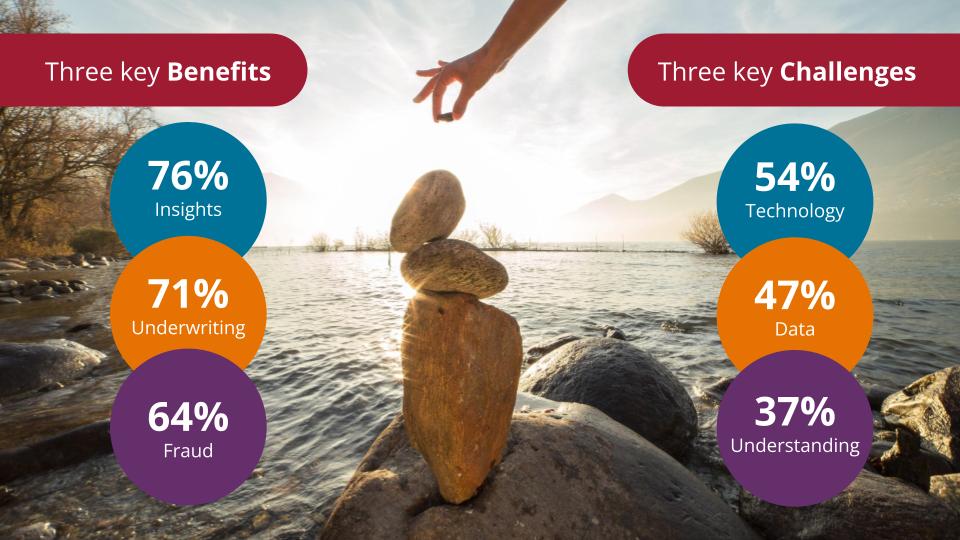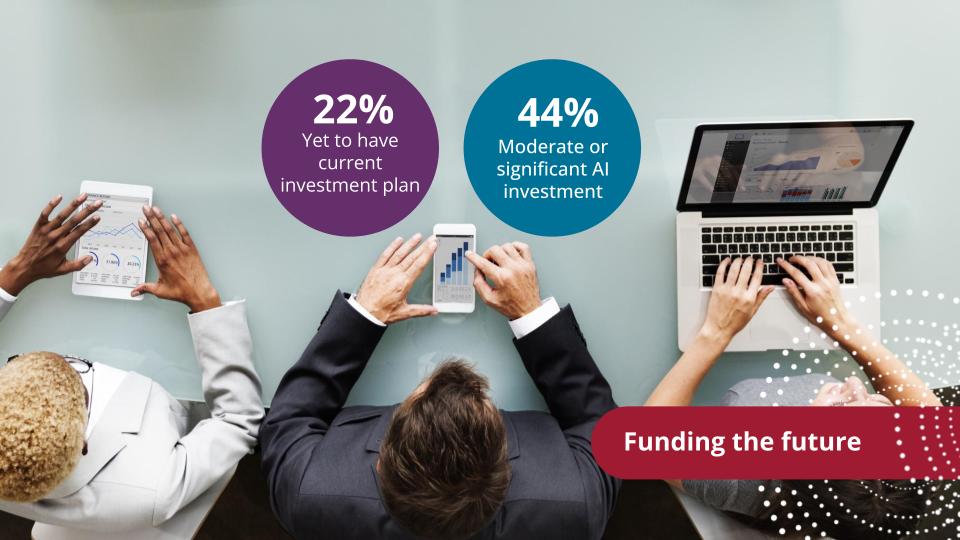Harnessing AI for Efficiency, Risk, and Fraud Protection
The rapid acceleration of Artificial Intelligence (AI) presents a transformative opportunity for credit management. A recent survey, conducted in partnership with AICM, confirms this forward-looking mindset across the credit management community.

The survey revealed that 77% of credit professionals surveyed now feel more positive about AI’s impact on their teams and industry compared to two years ago, with only 5% expressing negative sentiment.

Regardless of your current level of engagement - whether a curious starter or an advocate - an essential challenge is to integrate AI in a sustainable, safe, and scalable way to achieve your business goals. Survey participants identified the top anticipated benefits of AI as:
- Forward looking insights - 76%
- Improve credit application processing and underwriting - 71%
- Enhance fraud detection and prevention - 64%
Portfolio optimisation, compliance activities reporting, customer collections, contract preparation and management, cash flow, and budgeting were also cited as areas of expected benefit.

When asked about challenges to implementing AI:
- 54% cited having the right technology
- 47% the right amount of quality data to support reliable responses
A lack of understanding about AI, ethical concerns and resistance to change were also identified as additional challenges.
Preparing for an AI future is believed to necessitate at least moderate or significant reskilling, while a similar number of respondents highlighted the importance of strategic thinking and advisory skills.

With nearly half (44%) of respondents reporting moderate or significant funding already in place for AI investment:
- 3 out of 4 cited the greatest immediate opportunity was increased operational efficiency and cost reduction.
- Less than one in five believe AI will largely replace human activity over the next decade.
4 Ways AI Delivers Value in Credit Management
AI can be strategically applied across the credit lifecycle to move from a reactive to a proactive posture. Here are four practical ways AI can drive efficiency, mitigate risk, and enhance fraud protection in the credit management function.
1. Improve the efficiency of underwriting and processing
Having to wade through pages of documentation - financial statements, contracts and notes to accounts - all to support a credit application, has been a slow, manual, and time-intensive process. AI is transforming this with capabilities like Intelligent Document Processing (IDP), which reliably extracts, digitises, and understands context buried deep within text, even from inconsistent or handwritten documents. Generative AI can then go to work automatically evaluating the financial fundamentals and drafting the initial analyst commentary for your credit memo in support of recommending credit limits and terms. This includes highlighting the key financial trends, risks, and proposed considerations within the context of your credit policy settings.
Such a powerful boost in efficiency frees teams to focus on strategic activities and high-value decisions, all while maintaining appropriate governance and oversight for more complicated, larger-value, or higher-risk transactions.
2. Strengthening early warning systems for proactive risk mitigation
For decades, credit modeling has been like driving a car using primarily the rearview mirror. AI changes this by enabling the processing of real-time, forward-looking data. AI can stress test an entire portfolio against thousands of dynamic scenarios - from floods to global commodity price shocks - to understand concentration or contagion risks across your portfolio before they materialise, and provide immediate recommendations for optimisation.
Crucially, it pinpoints exactly where to apply your team's valuable human effort for the greatest strategic impact. This capability is about turning market chaos into a clear competitive advantage.
3. Fortifying the fraud front line to reduce risk exposure
Fraud is now an AI-powered problem, with malicious actors using agentic AI to automate attacks at a speed and scale that traditional rules-based systems simply cannot handle. They're using deepfakes to bypass identity and document checks and automating social engineering to exploit both processes and people. To fight this, you need a defense that learns and adapts at machine speed, and that's where AI is essential.
AI-powered fraud protection layers multiple defenses, from high-accuracy facial biometrics and deep fake detection to behavioral analytics that spot anomalies in real time. Crucially, these models use agentic AI to learn from every transaction across a network, seeking to identify 'patient zero' on a new fraud pattern before it becomes an epidemic. For credit managers, this capability solves the complex problem of defeating sophisticated fraudsters at account opening without locking out genuine customers. In an era of automated credit decisioning, this isn't just a safeguard, it's a necessity.
4. Gaining immediate strategic insights for confident decisioning
Imagine benchmarking your trading or credit portfolio's performance against a custom peer group or market segment instantly, without needing to learn new software. Conversational AI enables you to ask complex questions in plain English - for example,
"Show me which regions and sectors have had the greatest demand and credit enquiries for our trading products versus our competition and the broader market over the last two months".
The AI not only generates charts but also offers strategic recommendations for the best course of action. While such questions traditionally required days of analysis, this round-the-clock access to quality data and virtual analysts enables credit professionals to adapt quickly to market changes with confident decisioning.
Partnering and preparation

According to MIT’s State of AI in Business 2025 report, companies that partner with specialist providers are twice as likely to succeed in their AI initiatives than those trying to build everything in-house. Strategic partners can provide access to:
- World-class, secure technology platforms with the right governance and tools. This governance should demand interpretability, ensuring models can ‘show their work’ so every decision is defensible, fair, and sound. These platforms should provide a comprehensive, all-in-one view that connects every stage of the credit lifecycle, streamline trade relationships from onboarding to collections, and offer self-service configuration.
- Vast, unique multi-sourced, multi-faceted data sets that span numerous economic cycles, ensuring future-fit and reliable AI capabilities. While many of us know that a credit model is only as good as the data it's trained on, the same is true for AI capabilities. However, with AI, the stakes are higher: "garbage in, catastrophe out". For credit management, the quality, lineage, and balance of training data are not merely technical details; they are the foundation of fairness and accuracy.
- Access to dedicated account managers and experts who deeply understand your business is invaluable. The ability to connect with the right team who knows your operations inside and out can significantly reduce time and costs, while also ensuring you achieve your desired outcomes.
Choose partners with an unwavering commitment to responsible and explainable AI with guardrails. These guardrails include clear policies on data usage, rigorous model validation and backtesting, and ‘circuit breakers’ that halt automated decisions when a model behaves erratically. As a recent McKinsey report highlights, the goal is not just to build AI agents that perform tasks, but to build a system of controls around them that ensures they perform those tasks safely and reliably.
The market turn is happening now. By engaging with AI responsibly and strategically, we can become the strategists, captains, and stewards of growth we were always meant to be.
Contact Equifax today to discover how our AI-led solutions can help prepare your business to lead this change.
